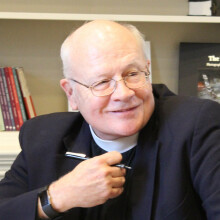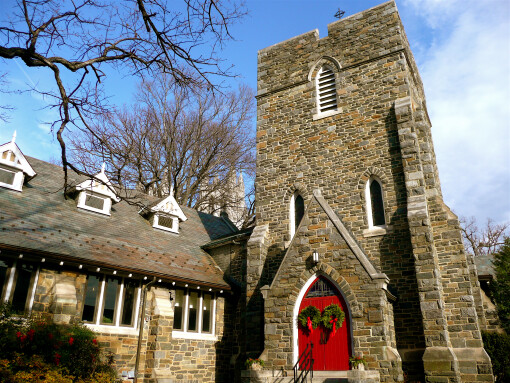Christ's Transfiguration--and Ours

Series: Epiphany
It’s an honor for me to be invited by Geoffrey to serve with you at St. Alban’s while Jim Quigley is on sabbatical leave, and it is my joy to be your preacher this morning. I recall that the last time I preached here was over twenty years ago, when I was the president of our Diocesan Clergy Association. In those days we had our monthly meetings at St. Alban’s and always began our programmatic year in September with a worship service here in the church. I preached on at least two of those occasions. I believe that today the Clergy Association is completely dormant, if not defunct—but happily, I am not defunct, so it is great to be with you today.
We come this morning to the last Sunday after the Epiphany—the end of a season that John Westerhoff once called a time of the dreams of childhood, in which anything is possible. An itinerant preacher, teacher and healer named Jesus is in the Galillean springtime of his ministry, and time and again we hear stories of how the light of God has been made manifest in this man. Our lectionary framers decided that it was fitting to always have the story of the Transfiguration on this Sunday, as a climax to the season; and we hear the story this year from the Gospel of Luke.
I have a fond memory connected to the story of the Transfiguration. Almost twelve years ago when I was on sabbatical leave from Christ Church, Rockville, I spent two weeks in a course of study at St. George’s College in Jerusalem. We toured around the old city and saw the sites of Jesus’ ministry, and we also ventured into the Galilee--to Nazareth, Cana, the Sea of Galilee, Capernaum, the Dead Sea, Caesarea Philippi—and, 11 miles from the Sea of Galilee, Mount Tabor, which is the Mount of Transfiguration. It rises alone some 1900 feet above the surrounding countryside, in the valley of Jezreel. It was a warm, sunny, breezy, pleasant day in June as we rode in a tour bus up the winding road toward the summit.
I had always found the story of Christ’s transfiguration to be strange, and unsettling, until my spiritual director said to me that it was simply a story about the disciples coming to see Jesus for whom he truly was. I was a Quaker for some ten years in my life when I was in my twenties, and for a long time I have treasured unadorned simplicity. As we rode along, I thought to myself, “Wouldn’t it be wonderful if when we got to the top of the mountain, there would be nothing there, except for the local vegetation and the panoramic view of the surrounding countryside? If only we could see the place as Jesus, Peter, James and John saw it!”
Of course, that was not the case. When you arrive at the top, you find a Franciscan monastery, one of two monasteries on the mountain, and a large magnificent church built by the Franciscans in 1924—replacing a Crusader church that had been there centuries before, and a Byzantine church that had been there centuries before the Crusaders. It is the Church of the Transfiguration, and high above the altar in the main worship area is a mosaic depicting the transfigured Christ, which shines radiantly when the sunlight falls upon it in the afternoon. There are also two chapels, one dedicated to Moses, and one to Elijah—as Peter said, “Master, it is good for us to be here; let us make three dwellings, one for you, one for Moses, and one for Elijah…” We human beings have a penchant for memorializing occasions, and so it is with the Transfiguration.
But I want us to return to the idea of simplicity, because I truly believe that the light of the transfigured Christ comes to us in two ways. The first is in the very ordinary, day-to-day moments of our existence, when we are living out what the poet Wallace Stevens called “the malady of the quotidian.” I have been bathed in this light in ordinary occurences, and in surprising ways—in the supermarket; in the hospital while visiting someone; on walks along woodland paths; in music concerts; while watching the snow fall on winter days. Suddenly you know in certain circumstances that Jesus Christ is present, hitherto in disguise, and the transcendent light is there.
And this light can come to all of us, if we open our senses and expand the limits of our spiritual imaginations. Recently I’ve been re-reading Gilead, a wonderful short novel by Marilynne Robinson. It is about an aging Protestant minister in rural Iowa, who knows that he will die soon from coronary disease. He married a young woman later in life, and they have a seven-year old son, to whom he is writing a long letter of personal reflections, which he hopes the son will read someday when the minister has departed this life, and the son is older. The minister refers frequently to all of his saved sermons from decades of ministry, which are packed in boxes and stored in the attic of his home. He figures that he has more pages of writing collected there than St. Augustine had in his lifetime. Yet he will not revisit any of them, and he has told his wife to burn them after his death. Toward the very end of the book he simply says:
It has seemed to me sometimes as though the Lord breathes in this poor gray ember of creation and it turns to radiance—for a moment or a year or the span of a life. And then it sinks back into itself again, and to look at it no one would know that it had anything to do with fire, or light…But the Lord is more constant and extravagant than it seems to imply. Wherever you turn your eyes the world can shine like transfiguration. You don’t have to bring a thing to it except a little willingness to see. Only, who would have the courage to see it?
The second way in which the light of God in Christ comes to us is in the dark, troubling moments of our lives—times in which we know that things are not the way we wish they could be. In the gospel text this morning we are told that Jesus, Peter, James and John went up on the mountain to pray “eight days after these sayings.” What has just preceded this passage is Jesus’ revelation that the son of Man will be rejected by the elders, the chief priests, and the scribes, and be killed, and on the third day be raised; and then, “If any want to become my followers, they must deny themselves, and take up their cross, and follow me.”
The Galillean springtime has ended—for Jesus, and for us. In three days we come to Ash Wednesday—our day of atonement. We are called to cast away our characteristic denial and know again in a very real way that we are mortal; and we have sinned, both individually, and corporately. Ours is a broken world, and ours is often a not very loving species. And yet, we carry within us this moment, and this memory, of the light of the transfigured Christ.
One of my favorite stories of the knowledge of this transfigured light in the dark time of the world, comes from Archbishop Desmond Tutu, in his wonderful book of devotional theology called God Has a Dream. During some of the worst days of apartheid, Archbishop Tutu struggled against all the objective facts of failure with the hope that God was going to bring about a new beginning in the country, because God is a God of justice, who cares about right and wrong. “Sometimes you had to whistle in the dark to keep your hopes up,” he writes, and “sometimes you wanted to whisper in God’s ear: ‘God, we know that You are in charge, but can’t you make it a little more obvious?’”
Tutu tells us that God did make it more obvious to him one August 6, which is the Feast of the Transfiguration in the Church’s calendar. He was meeting with some colleagues at a theological college to prepare for a discussion with the prime minister to discuss the many controversies that had erupted. The college was closed because of the government’s racist policies. Listen to Archbishop Tutu’s beautiful words:
During our discussions I went into the priory garden for some quiet. There was a huge Calvary—a large wooden cross without corpus, but with protruding nails and a crown of thorns. It was a stark symbol of the Christian faith. It was winter; the grass was pale and dry and nobody believed that in a few weeks’ time it would be lush and green and beautiful again. It would be transfigured.
As I sat quietly in the garden I realized the power of transfiguration—of God’s transformation—in our world. The principle of transfiguration is at work when something so unlikely as the brown grass that covers our veld in winter becomes bright green again. Or when the tree with gnarled leafless branches bursts forth with the sap flowing so that the birds sit chirping in the leafy branches. Or when the once dry streams gurgle with the swift-flowing water. When winter gives way to spring and nature seems to experience its own resurrection.
The principle of transfiguration says nothing, no one and no situation, is “untransfigurable”. That the whole of creation, nature, waits expectantly for its transfiguration, when it will be released from its bondage and share in the glorious liberty of the children of God, when it will be not just dry inert matter but will be translucent with divine glory.
Our Christian history, Desmond Tutu reminds us, is filled with stories of transfiguration, beginning with the most spectacular illustration of this principle—the Cross itself. “As I sat in the priory garden”, he writes, “I thought of our desperate political situation in the light of this principle of transfiguration and from that moment on, it has helped me to see with new eyes.”
In our customary time of silence, I invite you to think backward, or forward as you wish. You might think back on a time in which you were bathed in the light of the transfigured Christ and suddenly saw life in a new way—and you can simply give thanks to God for the gift of that time. Or you can look forward, and gaze for a moment on the troubled nation, and the world in which we live these days—and ask God for a way of seeing the transfiguration at work in the coming days, weeks, and months. In silence, and in response to the gospel, let us pray.
 Welcome to St. Alban’s Church! Every Sunday, and most days in between, people gather in this place to worship, to learn, to grow, to share the joys and struggles of our lives, and to seek God’s grace in the midst of our lives. We do not come because we have it all figured out, but because we are seeking light on the way. We come as we are and welcome one another.
Welcome to St. Alban’s Church! Every Sunday, and most days in between, people gather in this place to worship, to learn, to grow, to share the joys and struggles of our lives, and to seek God’s grace in the midst of our lives. We do not come because we have it all figured out, but because we are seeking light on the way. We come as we are and welcome one another.

